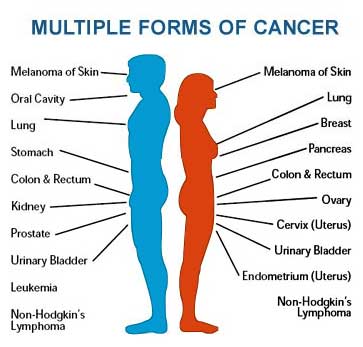
- Cancer (usually symbolized by a crab) is a non-communicable disease.
- Cancer is the unregulated and uncontrolled proliferation of cells or it is a breakdown of the regulating mechanism that governs normal cell division.
- The study of cancer is called oncology.
- The tumor (a mass of tissue of abnormal cells)or neoplasm formed by uncontrolled cell division can be of two types:
- Benign tumors:
- They are localized tumors and are bound within a connective tissue coating.
- They don’t spread over the surrounding tissues.
- They are not fatal or harmful. E.g. moles and warts
- Malignant tumors:
- They are cancerous and harmful and spread into the surrounding tissues by two means: invasion and metastasis.
- Invasion is the penetration of the cells of malignant tumor into the neighboring tissue where they from invasion tumors.
- Metastasis is the penetration of cancerous cell into the blood capillaries from where they are carried to different parts of the body.
- Benign tumors:
Types of cancer:
- Based on the types of tissues affected, cancer is of following types:
- Carcinoma:
- It is the cancer of the epithelial lining, which can be ectodermal, mesodermal or endodermal in origin.
- This type of cancer can develop in the gut lining, glands (exocrine or endocrine) or skin etc.
- About 80% of the cancers are carcinomas.
- g. lung cancer, breast cancer, duodenal cancer, colon cancer, skin cancer, cervix cancer etc.
- Sarcoma:
- It is the cancer of connective tissues or muscles, and is mesodermal in origin.
- Only 1-2% of cancers are of this type.
- g. cancer of bones and cartilages etc.
- Leukemia:
- It is the cancer of blood particularly of granulocytes (WBCs) and hence is also called granulocytic leukemia.
- It is a specific abnormality in chromosome 22 (Philadelphia chromosome) of leukemia cancer cells (particularly chronic myeloid leukemia (CML) cells).
- Lymphoma:
- It is the cancer of lymphatic tissues or lymphocytes present in the lymph.
- The most common lymphoma is Hodgkin’s disease.
- Mixed types of cancer:
- Lipoma: it is the cancer of adipose tissue subcutaneous fats (beneath the skin).
- Melanoma: the cancer of melanocytes present in skin.
- Teratoma: it is the cancer of embryonic or fetal tissue that is a tumor-like embryo or embryo-like tumor formed by the heterogeneous mixture of tissues.
- Myeloma: the cancer of bone marrow.
- Myoma: the caner of muscles.
Causes of cancer:
- The cancer causing agents or factors are called carcinogens.
- Carcinogens may be physical, chemical or biological factors.
- Physical agents (Radiations):
- UV rays, ϒ-rays (gamma rays), infra-red rays or X-rays can cause gene mutation and produce oncogenic transformation.
- The radiation from nuclear bombs and leakage from nuclear reactors can also cause mutation.
- Chemical agents:
- Certain chemicals may cause cancer e.g. n-nitroso-dimethylene (in cigarette smoke) and asbestos dust causing lung cancer.
- Cadmium oxide causing cancer of prostate gland, PVC (polyvinyl chloride) and Aflatoxin (from fungus Aspergillus) causing liver cancer.
- Nitrosamine causing colon cancer, diethylstilbestrol causing vaginal cancer.
- Biological agents (viruses):
- Viruses don’t cause cancer as pathogens but alter DNA sequence which produces abnormal proteins.
- Such viruses are called oncoviruses.
- Physical agents (Radiations):
Carcinogens can also be categorized on the basis of their mode of action as:
- DNA transformers: these agents can cause alteration in DNA that leads to cancer.
- Tumor promoters: these agents (e.g. growth factors or hormones) promote the proliferation of cells which have already undergone genetic alteration.
- Tumor viruses: such viruses are capable of making oncogenic transformations
